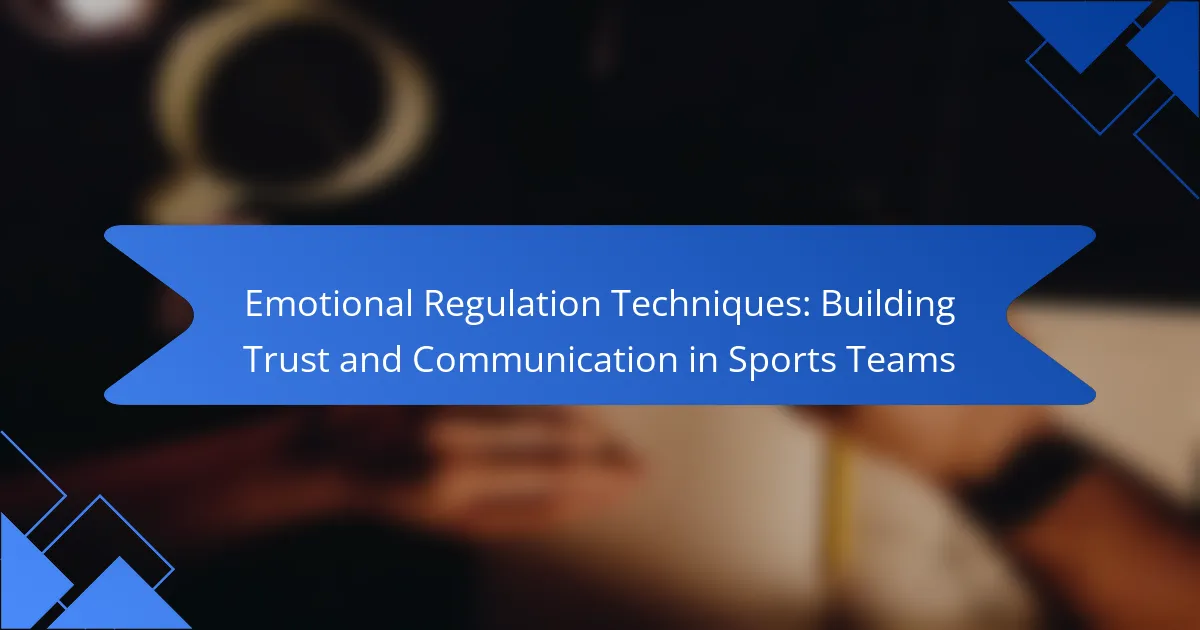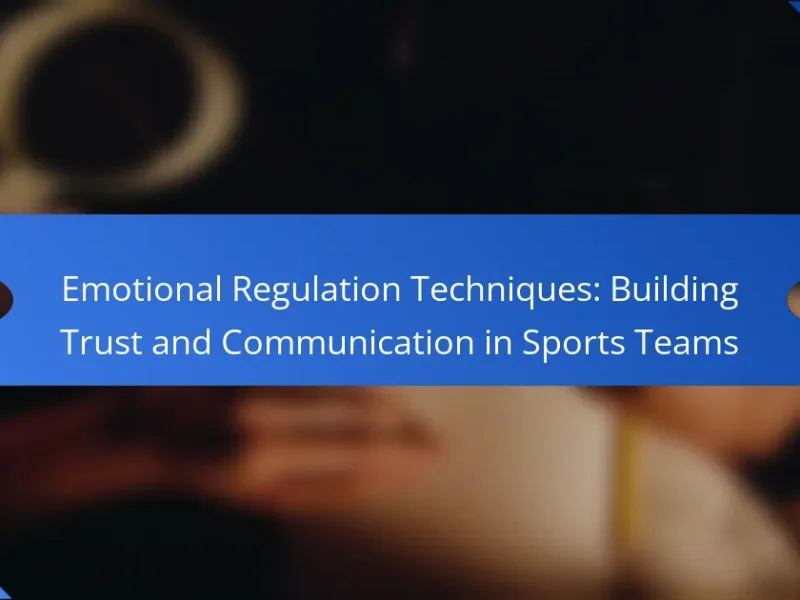Emotional regulation techniques enhance trust and communication within sports teams, addressing challenges like stress and anxiety. Key methods include mindfulness, cognitive restructuring, and emotional expression. These techniques foster self-awareness, adaptive coping strategies, and open dialogue among team members. Implementing these practices creates a supportive environment that boosts performance and collaboration.
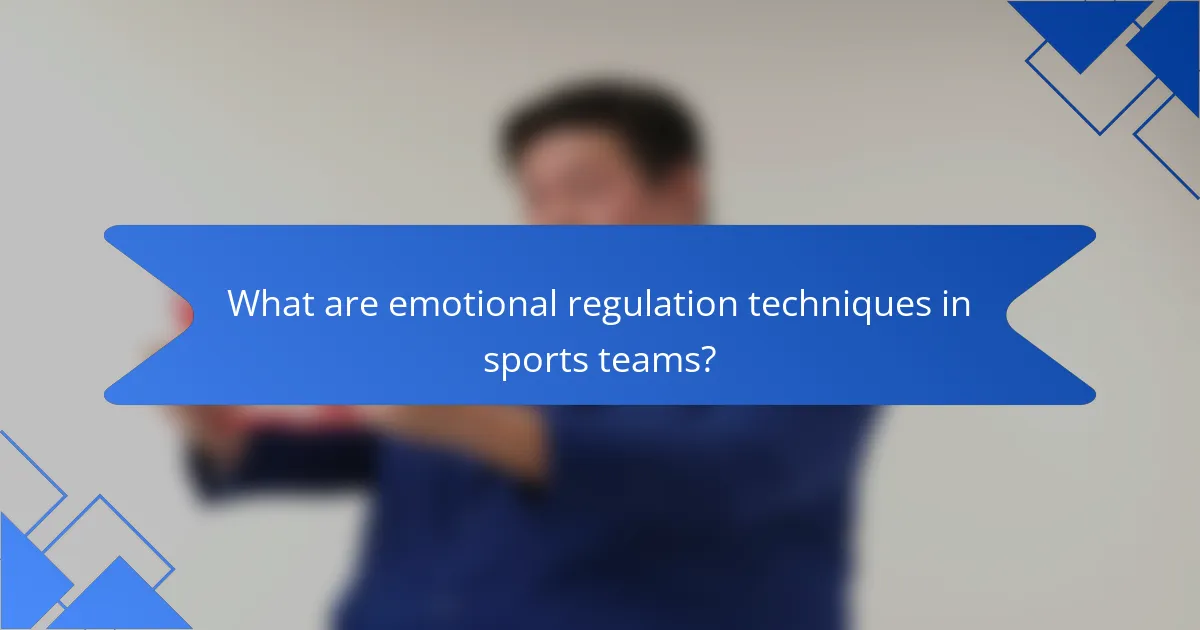
What are emotional regulation techniques in sports teams?
Emotional regulation techniques in sports teams enhance trust and communication among members. Techniques include mindfulness, cognitive restructuring, and emotional expression. Mindfulness helps athletes stay present, reducing anxiety. Cognitive restructuring enables reframing negative thoughts into positive ones. Emotional expression fosters open dialogue, promoting team cohesion. These techniques build a supportive environment, improving performance and collaboration.
How do emotional regulation techniques enhance trust among team members?
Emotional regulation techniques enhance trust among team members by fostering open communication and reducing conflict. These techniques promote self-awareness, enabling individuals to understand their emotions and reactions. As a result, team members can express concerns constructively, leading to a supportive environment. Moreover, practicing emotional regulation builds empathy, allowing team members to relate to each other’s experiences, further strengthening trust. Consistent application of these techniques can transform team dynamics, creating a culture of collaboration and mutual respect.
What role does communication play in emotional regulation within teams?
Effective communication is crucial for emotional regulation within teams. It fosters understanding and trust, enabling team members to express emotions constructively. Open dialogue helps identify stressors and facilitates collaborative problem-solving. Regular check-ins and feedback loops reinforce emotional awareness, promoting a supportive environment. This proactive approach enhances team cohesion and performance.
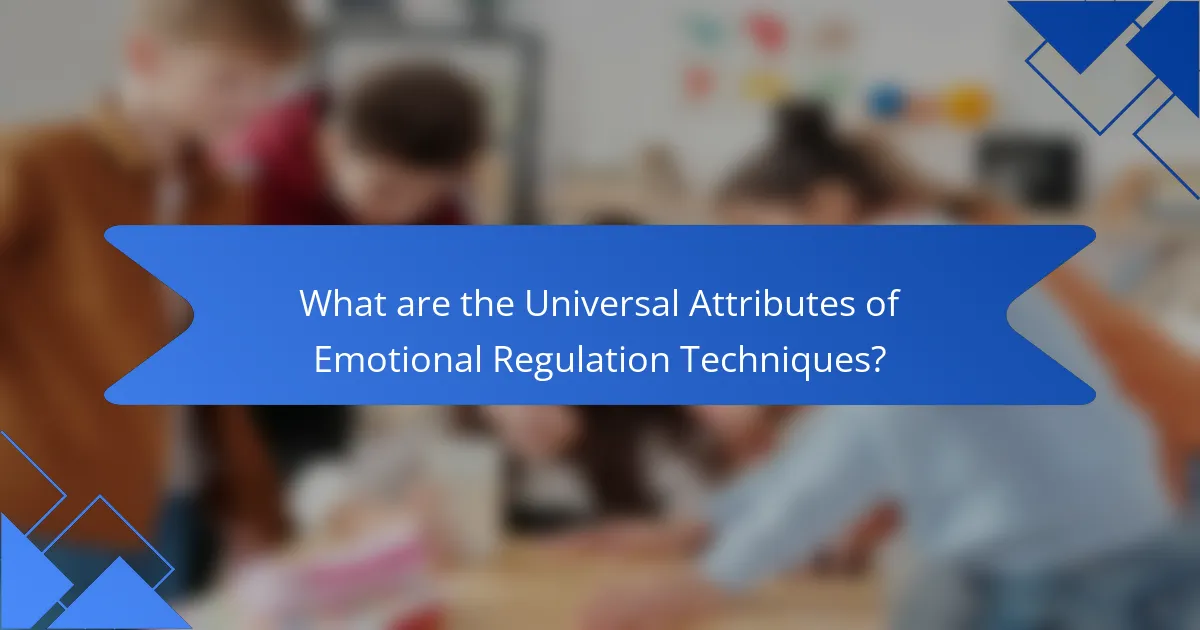
What are the universal attributes of emotional regulation techniques?
Emotional regulation techniques share universal attributes that enhance team dynamics. These techniques promote self-awareness, emotional expression, and adaptive coping strategies. They also foster trust and open communication, essential for effective teamwork. Techniques like mindfulness and cognitive restructuring help athletes manage stress and improve performance.
How do emotional awareness and expression contribute to team dynamics?
Emotional awareness and expression enhance team dynamics by fostering trust and communication. When team members recognize and articulate their emotions, they create an environment of openness. This transparency leads to stronger interpersonal connections and collaborative efforts. As a result, teams can address conflicts more effectively and improve overall performance. Emotional regulation techniques, such as active listening and empathy, further support this dynamic by promoting understanding and reducing misunderstandings.
What impact does emotional regulation have on team performance?
Emotional regulation significantly enhances team performance by fostering trust and effective communication. Teams that practice emotional regulation techniques experience improved collaboration and decision-making. For instance, athletes who manage their emotions can maintain focus and resilience during high-pressure situations, leading to better outcomes. Research indicates that teams with high emotional intelligence outperform their peers, as they navigate conflicts and stress more effectively. Overall, emotional regulation serves as a foundational element in building cohesive, high-performing sports teams.
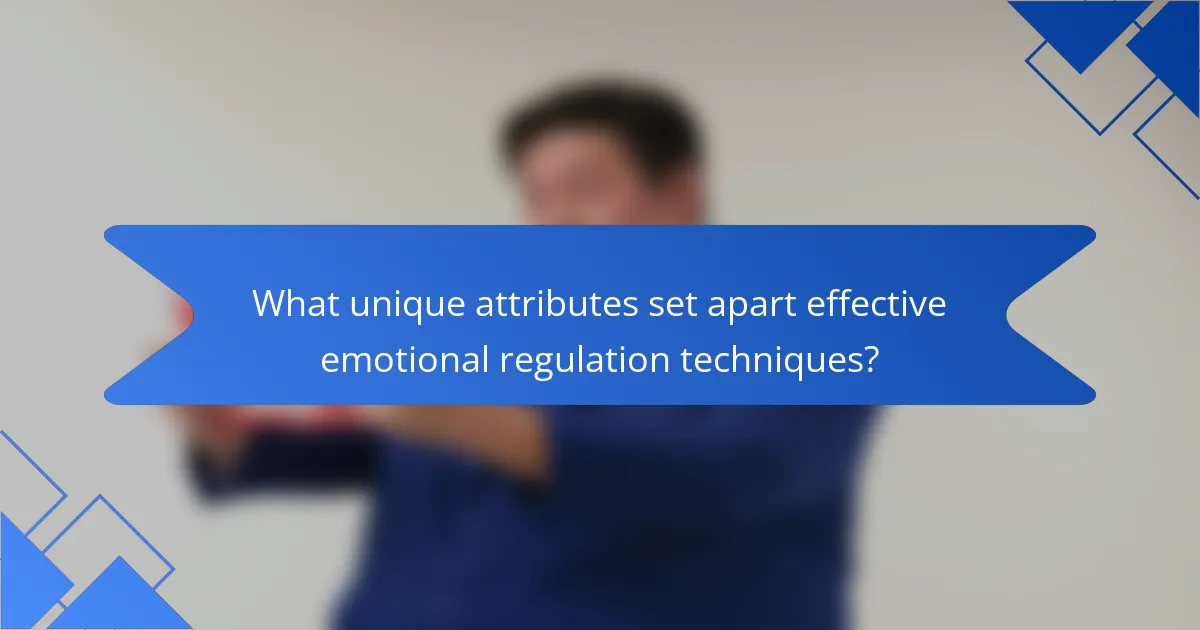
What unique attributes set apart effective emotional regulation techniques?
Effective emotional regulation techniques foster trust and communication in sports teams through unique attributes like adaptability, mindfulness, and emotional awareness. Adaptability allows techniques to be tailored to individual needs, enhancing team dynamics. Mindfulness promotes present-moment awareness, reducing stress and improving focus during competition. Emotional awareness helps team members recognize their own and others’ feelings, facilitating better communication and conflict resolution. These attributes collectively enhance team cohesion and performance.
How can personalized emotional regulation strategies strengthen team bonds?
Personalized emotional regulation strategies enhance team bonds by fostering trust and improving communication. Tailored techniques address individual emotional needs, creating an environment of mutual support. By utilizing methods such as mindfulness and constructive feedback, teams can navigate conflicts effectively. As a result, emotional resilience develops, strengthening interpersonal connections. This unique approach leads to higher team cohesion and performance.
What specific approaches do successful teams use for emotional regulation?
Successful teams use approaches like open communication, mindfulness practices, and structured feedback to regulate emotions. These techniques build trust and enhance team cohesion. Open communication fosters a safe environment where team members express feelings. Mindfulness practices, such as breathing exercises, help manage stress during high-pressure situations. Structured feedback sessions provide opportunities for reflection and improvement, reinforcing a supportive team culture. These strategies collectively enhance emotional resilience, leading to better performance.
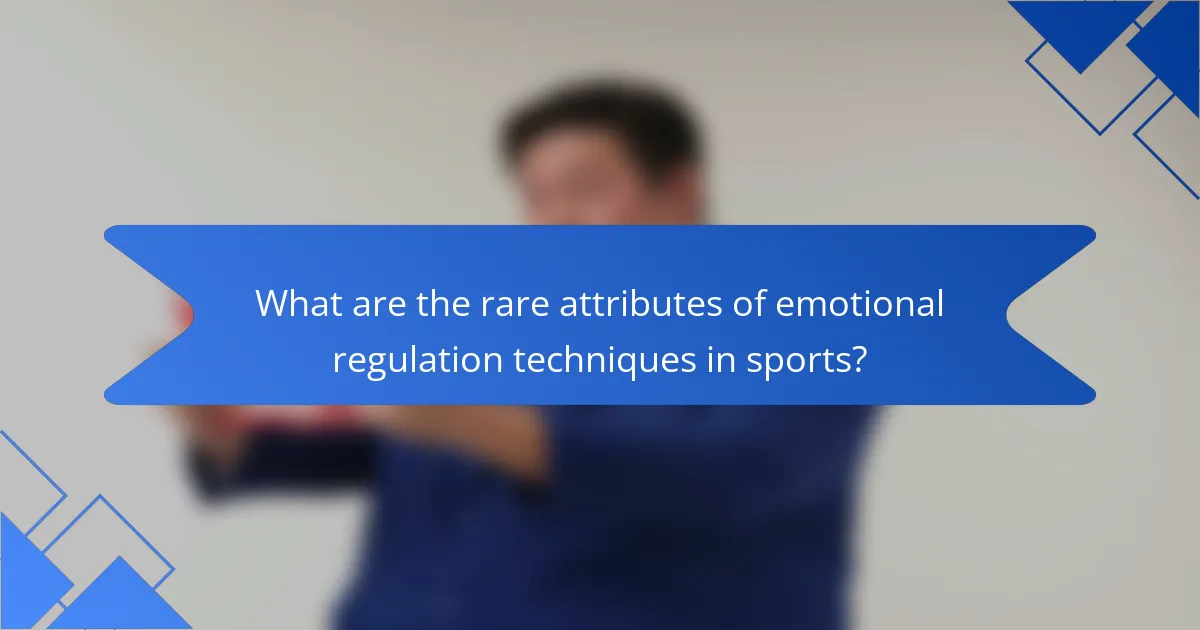
What are the rare attributes of emotional regulation techniques in sports?
Rare attributes of emotional regulation techniques in sports include individualized approaches, culturally specific practices, and integration of mindfulness. These techniques often emphasize trust-building through unique communication styles and personalized feedback mechanisms. Additionally, some methods may incorporate artistic expressions, such as music or visual arts, to enhance emotional awareness and team cohesion.
How do cultural factors influence emotional regulation in international teams?
Cultural factors significantly influence emotional regulation in international teams by shaping communication styles and trust-building strategies. Different cultures prioritize distinct emotional expressions and conflict resolution methods. For example, collectivist cultures may emphasize harmony and indirect communication, while individualistic cultures may value directness and assertiveness. Understanding these differences fosters effective collaboration and enhances team dynamics. Recognizing cultural nuances in emotional regulation techniques promotes trust and improves overall communication in diverse sports teams.
What innovative practices have emerged in emotional regulation for sports teams?
Innovative practices in emotional regulation for sports teams focus on fostering trust and enhancing communication. Techniques such as mindfulness training, team-building exercises, and emotional intelligence workshops have gained traction. These methods build resilience, improve interpersonal relationships, and enhance overall team cohesion. For example, mindfulness practices help athletes manage stress and maintain focus during high-pressure situations. As a result, teams that implement these practices often report improved performance and stronger bonds among members.

What are the best practices for implementing emotional regulation techniques?
To effectively implement emotional regulation techniques in sports teams, focus on fostering an environment of trust and open communication. Encourage team members to express their feelings and thoughts, which builds rapport and enhances emotional awareness. Regular training sessions on emotional intelligence can equip athletes with the skills to manage their emotions constructively.
Incorporating mindfulness practices, such as breathing exercises or meditation, can help team members regulate their emotions during high-pressure situations. Establishing clear communication channels allows for immediate feedback and conflict resolution, reinforcing team cohesion. Lastly, recognizing individual emotional triggers and responses promotes a supportive atmosphere where members can thrive.
How can teams create a culture of open communication?
Teams can create a culture of open communication by implementing emotional regulation techniques. These techniques help build trust, enabling members to express thoughts and feelings without fear. Regular team meetings foster dialogue, while active listening promotes understanding. Encouraging feedback creates a safe space for sharing ideas. Establishing clear communication norms ensures everyone is on the same page. Training sessions on emotional intelligence can enhance interpersonal skills, leading to stronger relationships within the team.
What common mistakes should teams avoid when applying emotional regulation techniques?
Teams should avoid common mistakes like neglecting individual emotional needs, failing to communicate openly, and not practicing techniques consistently. These errors can hinder trust and effective communication. Additionally, overlooking the importance of feedback and not adapting strategies to team dynamics can lead to misunderstandings. Prioritizing emotional awareness and creating a supportive environment enhances emotional regulation success in sports teams.
What expert insights can enhance emotional regulation in sports teams?
Expert insights for enhancing emotional regulation in sports teams include fostering open communication, building trust among team members, and implementing structured emotional training. Open communication allows athletes to express feelings and concerns, which can reduce anxiety and improve performance. Building trust creates a safe environment, enabling team members to rely on each other during high-pressure situations. Structured emotional training teaches techniques such as mindfulness and cognitive reframing, which help athletes manage their emotions effectively. These approaches collectively enhance team cohesion and resilience.
